Abstract
Fast freezing and slow thawing of Salmonella anatum cells suspended in water resulted in injury of more than 90% of the cells that survived the treatment. The injured cells failed to form colonies on the selective medium (xyloselysine-peptone-agar with 0.2% sodium deoxycholate) but did form colonies on a nonselective (xylose-lysine-peptone-agar) plating medium. In Tryptic soy plus 0.3% yeast extract broth or minimal broth, most of the injured cells repaired within 1 to 2 hr at 25 C. Tryptic soy plus yeast extract broth supported repair to a greater extent than minimal broth. Phosphate or citrate at concentrations found in minimal broth supported repair of some cells. MgSO4, when present with inorganic phosphate or citrate or both, increased the extent of repair. The repair process in the presence of phosphate was not prevented by actinomycin D, chloramphenicol, and D-cycloserine, but was prevented by cyanide and 2,4-dinitrophenol (only at pH 6). This suggested that the repair process might involve energy metabolism in the form of adenosine triphosphate. The freeze-injured cells were highly sensitive to lysozyme, whereas unfrozen fresh cells were not. In the presence of phosphate or minimal broth this sensitivity was greatly reduced. This suggested that, at least in some of the cells, the injury involved the lipopolysaccharide of the cell wall and adenosine triphosphate synthesis was required for repair.
Full text
PDF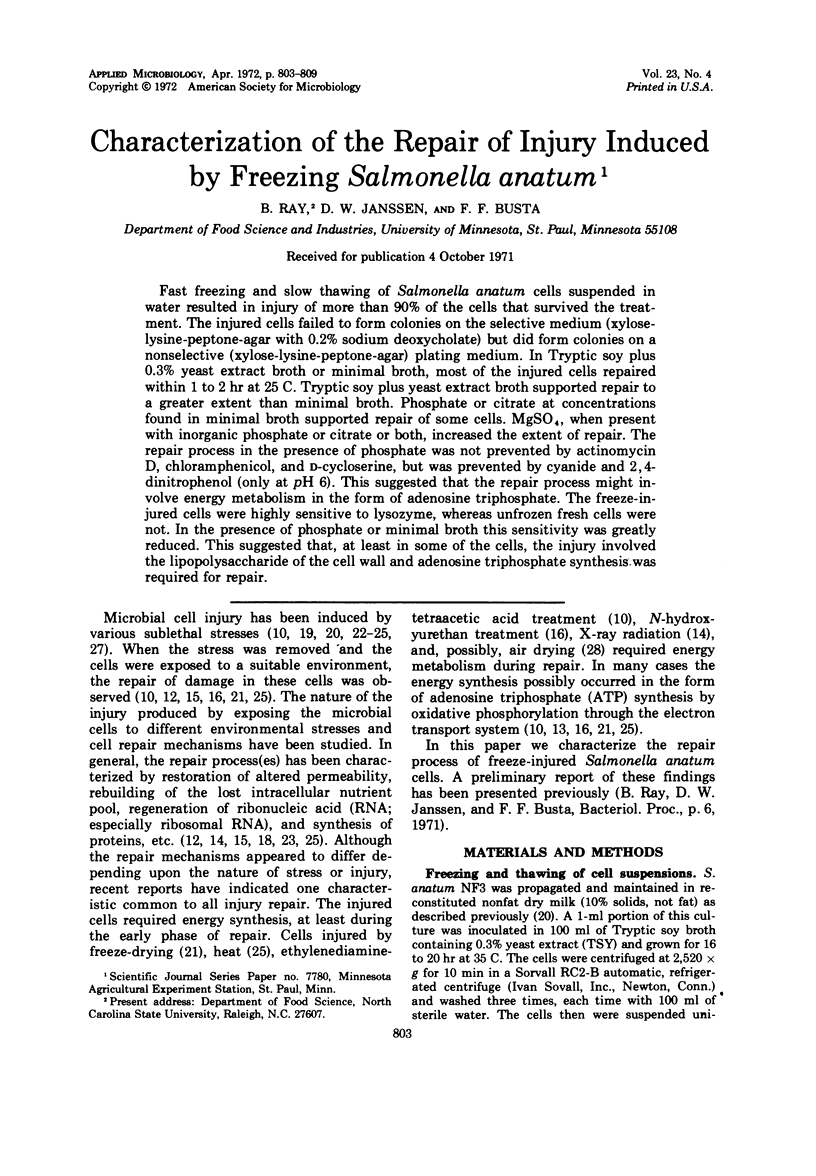

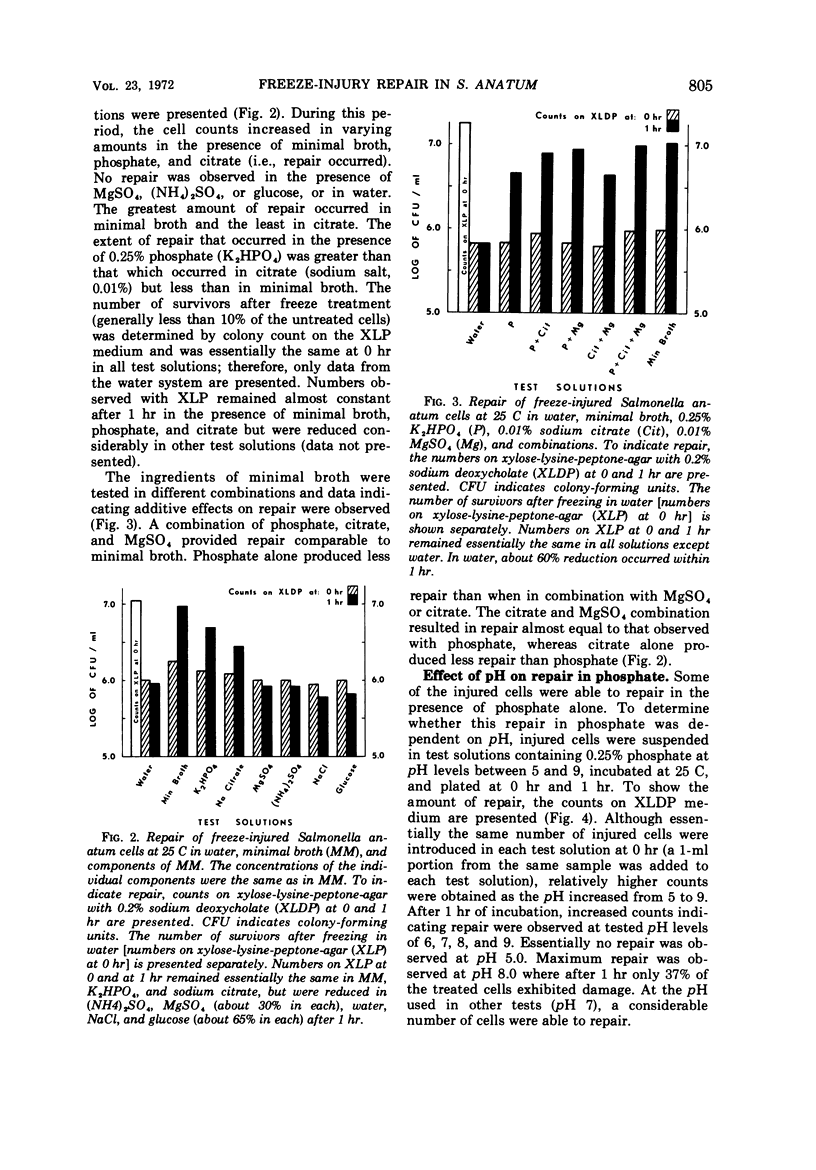
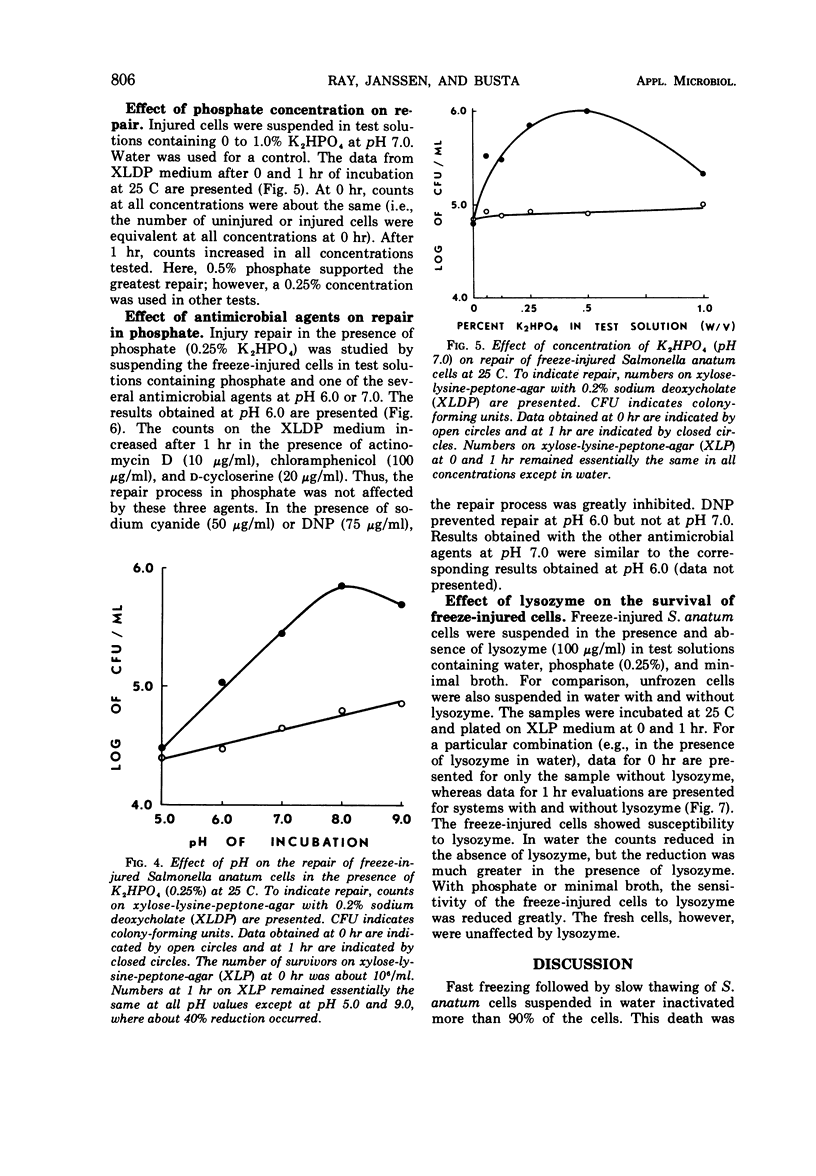
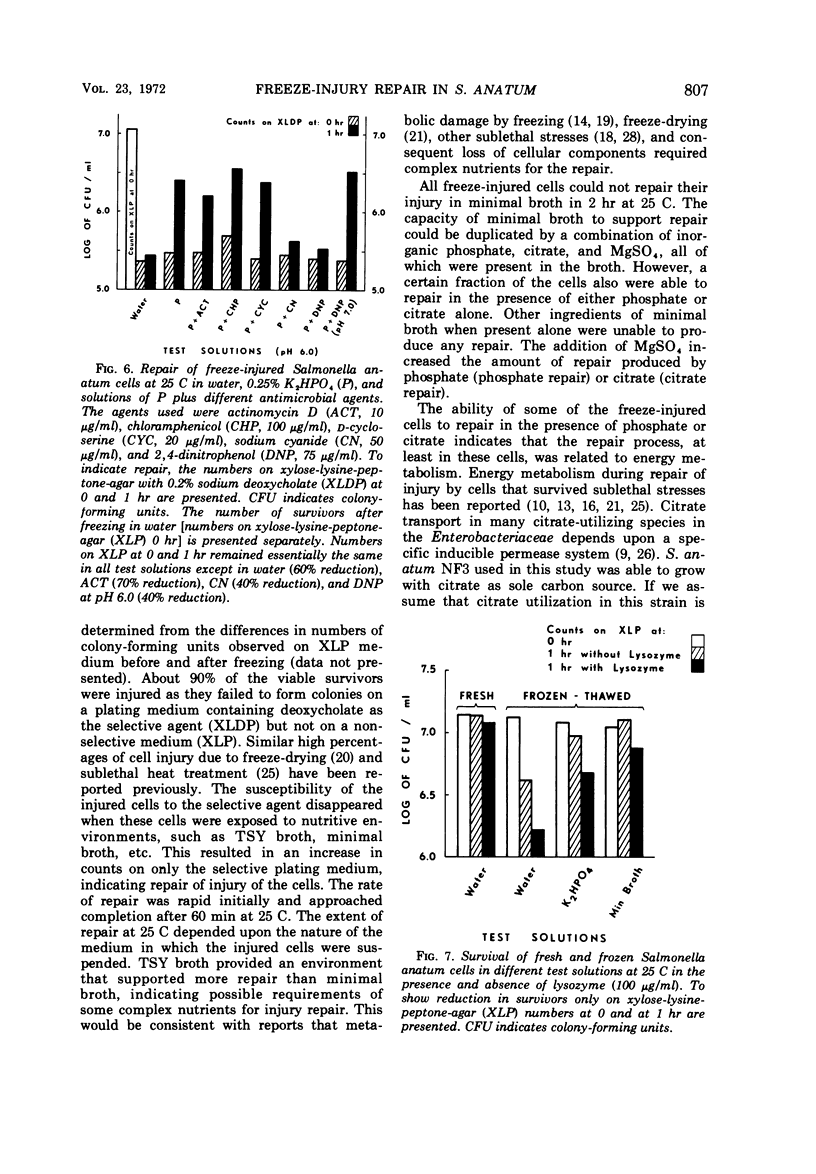
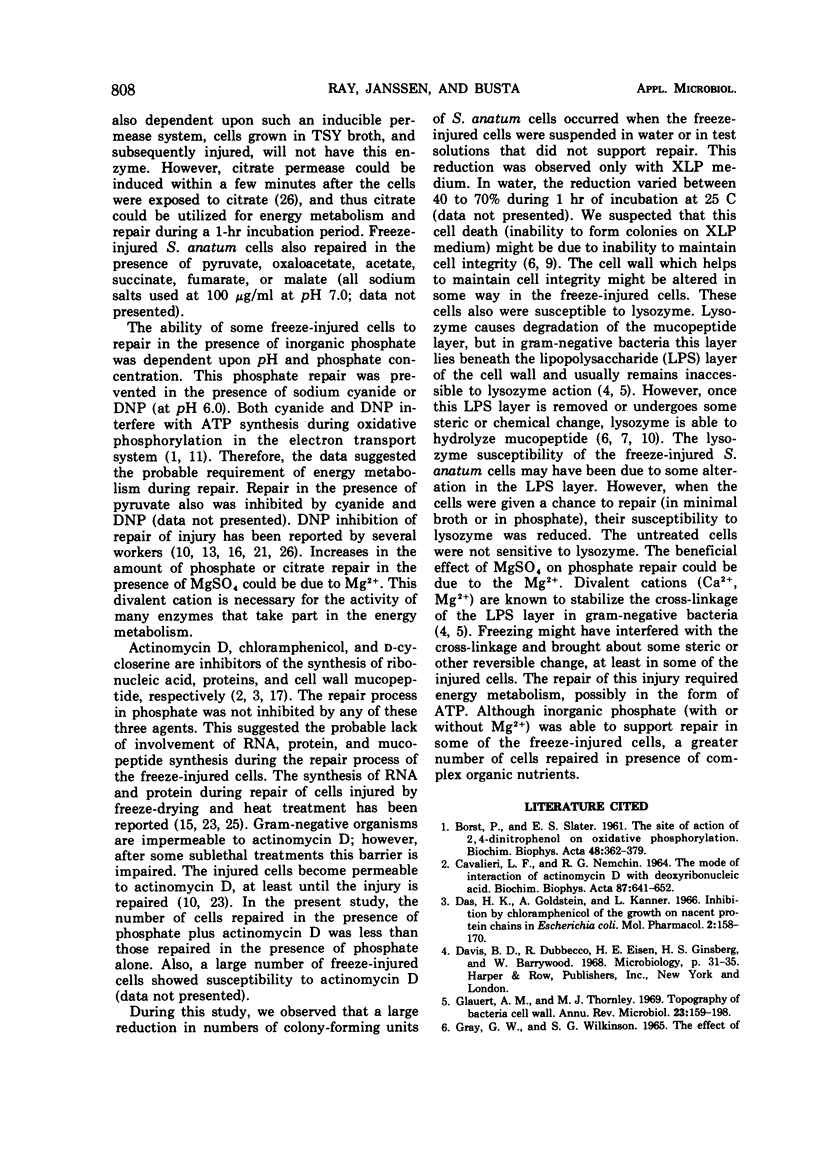
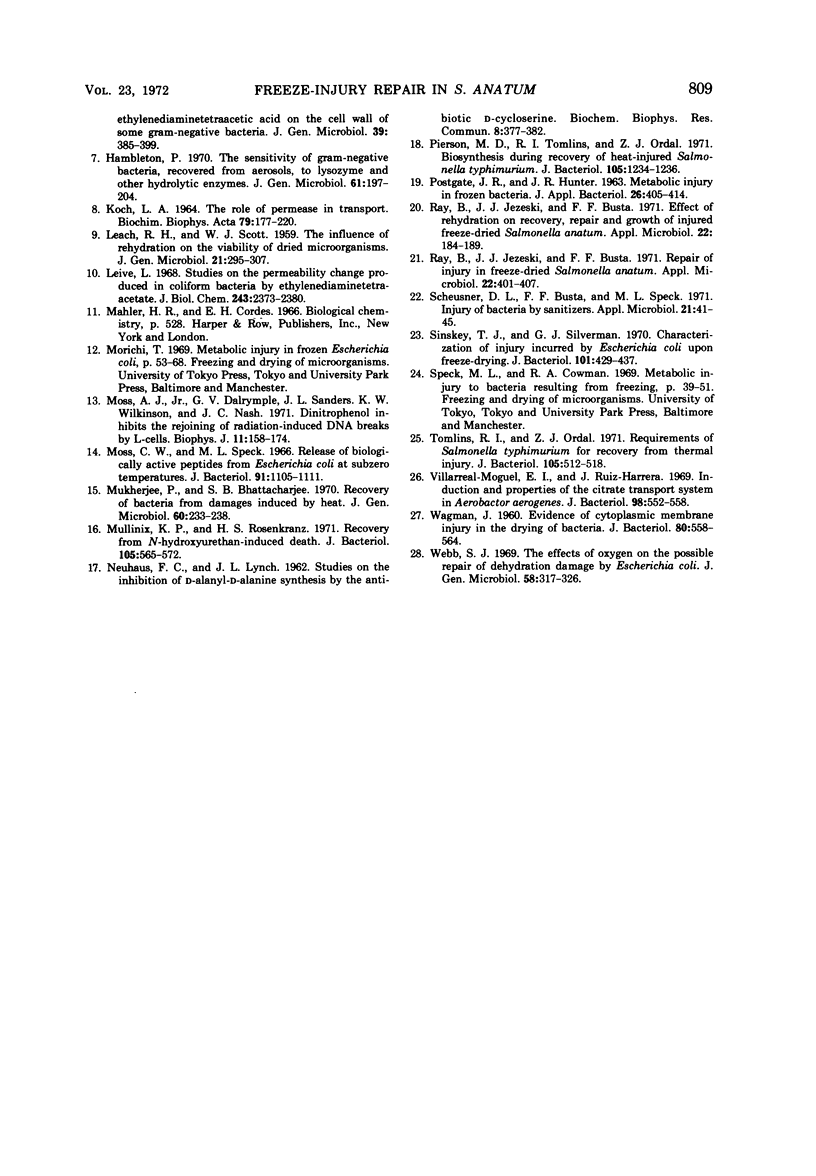
Selected References
These references are in PubMed. This may not be the complete list of references from this article.
- CAVALIERI L. F., NEMCHIN R. G. THE MODE OF INTERACTION OF ACTINOMYCIN D WITH DEOXYRIBONUCLEIC ACID. Biochim Biophys Acta. 1964 Aug 12;87:641–652. doi: 10.1016/0926-6550(64)90282-8. [DOI] [PubMed] [Google Scholar]
- Das H. K., Goldstein A., Kanner L. C. Inhibition by chlorampenicol of the growth of nascent protein chains in Escherichia coli. Mol Pharmacol. 1966 Mar;2(2):158–170. [PubMed] [Google Scholar]
- Glauert A. M., Thornley M. J. The topography of the bacterial cell wall. Annu Rev Microbiol. 1969;23:159–198. doi: 10.1146/annurev.mi.23.100169.001111. [DOI] [PubMed] [Google Scholar]
- Gray G. W., Wilkinson S. G. The effect of ethylenediaminetetra-acetic acid on the cell walls of some gram-negative bacteria. J Gen Microbiol. 1965 Jun;39(3):385–399. doi: 10.1099/00221287-39-3-385. [DOI] [PubMed] [Google Scholar]
- Hambleton P. The sensitivity of gram-negative bacteria, recovered from aerosols, to lysozyme and other hydrolytic enzymes. J Gen Microbiol. 1970 May;61(2):197–204. doi: 10.1099/00221287-61-2-197. [DOI] [PubMed] [Google Scholar]
- KOCH A. L. THE ROLE OF PERMEASE IN TRANSPORT. Biochim Biophys Acta. 1964 Jan 27;79:177–200. doi: 10.1016/0926-6577(64)90050-6. [DOI] [PubMed] [Google Scholar]
- LEACH R. H., SCOTT W. J. The influence of rehydration on the viability of dried micro-organisms. J Gen Microbiol. 1959 Oct;21:295–307. doi: 10.1099/00221287-21-2-295. [DOI] [PubMed] [Google Scholar]
- Leive L. Studies on the permeability change produced in coliform bacteria by ethylenediaminetetraacetate. J Biol Chem. 1968 May 10;243(9):2373–2380. [PubMed] [Google Scholar]
- Moss A. J., Jr, Dalrymple G. V., Sanders J. L., Wilkinson K. P., Nash J. C. Dinitrophenol inhibits the rejoining of radiation-induced DNA breaks by L-cells. Biophys J. 1971 Feb;11(2):158–174. doi: 10.1016/S0006-3495(71)86205-7. [DOI] [PMC free article] [PubMed] [Google Scholar]
- Moss C. W., Speck M. L. Release of biologically active peptides from Escherichia coli at subzero temperatures. J Bacteriol. 1966 Mar;91(3):1105–1111. doi: 10.1128/jb.91.3.1105-1111.1966. [DOI] [PMC free article] [PubMed] [Google Scholar]
- Mukherjee P., Bhattacharjee S. B. Recovery of bacteria from damages induced by heat. J Gen Microbiol. 1970 Feb;60(2):233–238. doi: 10.1099/00221287-60-2-233. [DOI] [PubMed] [Google Scholar]
- Mullinix K. P., Rosenkranz H. S. Recovery from N-hydroxyurethan-induced death. J Bacteriol. 1971 Feb;105(2):565–572. doi: 10.1128/jb.105.2.565-572.1971. [DOI] [PMC free article] [PubMed] [Google Scholar]
- NEUHAUS F. C., LYNCH J. L. Studies on the inhibition of D-alanyl-D-alanine synthetase by the antibiotic D-cycloserine. Biochem Biophys Res Commun. 1962 Aug 7;8:377–382. doi: 10.1016/0006-291x(62)90011-6. [DOI] [PubMed] [Google Scholar]
- Pierson M. D., Tomlins R. I., Ordal Z. J. Biosynthesis during recovery of heat-injured Salmonella typhimurium. J Bacteriol. 1971 Mar;105(3):1234–1236. doi: 10.1128/jb.105.3.1234-1236.1971. [DOI] [PMC free article] [PubMed] [Google Scholar]
- Ray B., Jezeski J. J., Busta F. F. Effect of rehydration on recovery, repair, and growth of injured freeze-dried Salmonella anatum. Appl Microbiol. 1971 Aug;22(2):184–189. doi: 10.1128/am.22.2.184-189.1971. [DOI] [PMC free article] [PubMed] [Google Scholar]
- Ray B., Jezeski J. J., Busta F. F. Repair of injury in freeze-dried Salmonella anatum. Appl Microbiol. 1971 Sep;22(3):401–407. doi: 10.1128/am.22.3.401-407.1971. [DOI] [PMC free article] [PubMed] [Google Scholar]
- Scheusner D. L., Busta F. F., Speck M. L. Injury of bacteria by sanitizers. Appl Microbiol. 1971 Jan;21(1):41–45. doi: 10.1128/am.21.1.41-45.1971. [DOI] [PMC free article] [PubMed] [Google Scholar]
- Sinskey T. J., Silverman G. J. Characterization of injury incurred by Escherichia coli upon freeze-drying. J Bacteriol. 1970 Feb;101(2):429–437. doi: 10.1128/jb.101.2.429-437.1970. [DOI] [PMC free article] [PubMed] [Google Scholar]
- Tomlins R. I., Ordal Z. J. Requirements of Salmonella typhimurium for recovery from thermal injury. J Bacteriol. 1971 Feb;105(2):512–518. doi: 10.1128/jb.105.2.512-518.1971. [DOI] [PMC free article] [PubMed] [Google Scholar]
- Villarreal-Moguel E. I., Ruiz-Herrera J. Induction and properties of the citrate transport system in Aerobacter aerogenes. J Bacteriol. 1969 May;98(2):552–558. doi: 10.1128/jb.98.2.552-558.1969. [DOI] [PMC free article] [PubMed] [Google Scholar]
- WAGMAN J. Evidence of cytoplasmic membrane injury in the drying of bacteria. J Bacteriol. 1960 Oct;80:558–564. doi: 10.1128/jb.80.4.558-564.1960. [DOI] [PMC free article] [PubMed] [Google Scholar]
- Webb S. J. The effects of oxygen on the possible repair of dehydration damage by Escherichia coli. J Gen Microbiol. 1969 Nov;58(3):317–326. doi: 10.1099/00221287-58-3-317. [DOI] [PubMed] [Google Scholar]


